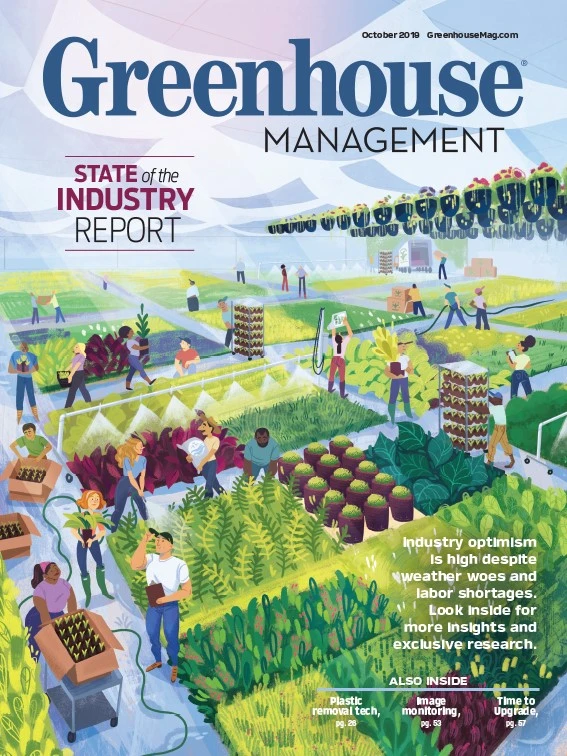
Photo courtesy of Emily Knehs

Emily Knehs, owner of Lost Mesa Flower Company in Hotchkiss, Colorado, has some ideas for keeping her business healthy and profitable in 2019 and beyond.
While some growers are reducing production of ornamentals or getting out of them altogether, she says that if she could pick one crop to grow more of, it would be pansies.
“Pansies are far and away our best-seller,” she says. “It seems simple, but with the climate that we’re at here in Colorado, pansies are just one of those things that are always in demand and we can’t grow enough of.”
Hotchkiss is a couple of hours from ski towns like Aspen, Telluride and Crested Butte — all with elevations at about 8,000 feet or higher and average summer nighttime low temperatures in the 30s and 40s. Knehs’ independent garden center customers appreciate pansies’ tolerance to cold and fluctuating temperatures.
Another, at least local, trend that Knehs has caught onto is the desire for many of her independent garden center and landscaper customers to purchase crops in mixes.
“I still see that there’s a lot of potential, at least in our area, for custom-growing and growing different sizes of containers and finished patio pots for the instant color, for the vacation homeowners,” she says.
Despite its seizing onto approaches that work, Lost Mesa Flower Company is, like much of the industry, a business in flux, trying to adjust to changes within and outside of horticulture.
Just between 2018 and 2019, Knehs noticed that many greenhouses, especially on Colorado’s Western Slope — the part of the state west of the Continental Divide — stopped growing ornamentals to cultivate cannabis and hemp.
“The more ornamental growers get out of that business and switch to the other business, the busier I get,” she says.
While the bump in business has provided her with increased revenue and profits, it has been a challenge to grow more product for, and ship more product to, her customers.

Finding the labor to deliver product has been particularly tough. Knehs has one employee who plants before shipping starts, then becomes the driver. However, in the peak season, she needs a full-time driver.
“It’s kind of challenging because you’re looking to hire somebody who is going to work for you for two and a half, three months, and in those two and a half, three months, the hours are going to be pretty demanding,” she says, adding that the job would also be highly physical.
Finding people to work in the greenhouse has not been a problem, though. Knehs is the business’ only full-time employee, managing about 26,000 square feet of greenhouse production and 16 irrigated acres outdoors for hay production. She has 10 seasonal employees, the majority of whom work from March until June.
“Then I have some that I keep on almost as a year-round sort of employee where we can do just cleaning and maintenance and other improvements that we need to do in the off-season,” she says.
Although cannabis and hemp have required Lost Mesa to grow more ornamentals to meet demand, Knehs says she is considering converting about two thirds of her hay production into hemp cultivation.
“I would like to partner with an experienced team that could utilize the acreage and also supplement my business’ income and cash flow,” she says.
Additional challenges for the company have been swings in climate.
“One of the big changes from last year to this year is that last year we had just a terrible, terrible drought, and it was so hot and so dry. Last year, we had ... more spider mites and that sort of thing,” Knehs says. “This year was 180 degrees the opposite. We had a really cold, wet winter, really cold, wet spring, so then you start to get all the other ones — the mold and the fungus gnats and those kinds of things.”
To be more sustainable, Lost Mesa Flower Company has initiated practices such as recycling the boxes it receives plugs in and plastics from its customers. The company is also transitioning to watering on automated timers.
In addition, Lost Mesa works with its local trash company, Double J Disposal, to recycle cardboard. The grower has a “very large cardboard bin” from the garbage collector, Knehs says.
“It took a lot of space to store the cardboard and time to load and unload at the landfill, not to mention the environmental impact,” she says. “Now that we have the weekly recycling service, it saves time, keeps our facility neat and organized, and keeps the cardboard, which is easily recyclable, out of the landfill.”

Explore the October 2019 Issue
Check out more from this issue and find your next story to read.
Latest from Greenhouse Management
- Anthura acquires Bromelia assets from Corn. Bak in Netherlands
- Top 10 stories for National Poinsettia Day
- Langendoen Mechanical hosts open house to showcase new greenhouse build
- Conor Foy joins EHR's national sales team
- Pantone announces its 2026 Color of the Year
- Syngenta granted federal registration for Trefinti nematicide/fungicide in ornamental market
- A legacy of influence
- HILA 2025 video highlights: John Gaydos of Proven Winners





